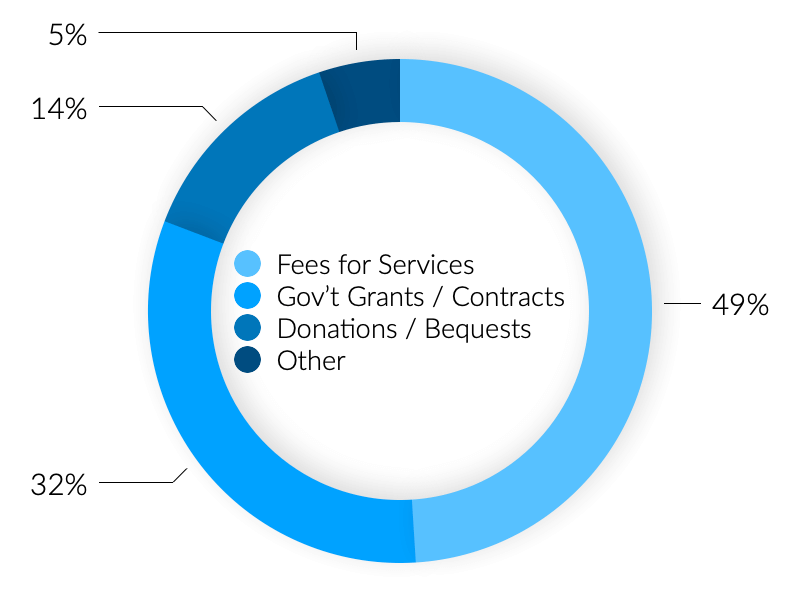Improving Grant Financial Management with Time Tracking
Table of Contents
Transparency, accountability, and compliance: three ubiquitous words in the nonprofit sector.
Although media usage and public outcries of one or more of these words have dramatically increased in recent years, they have been the bedrock of nonprofit operations for much longer.
Nonprofit organizations provide services to millions of people annually. Some provide goods like food, clothing, shelter, and medicine to benefit clients. However, unlike a for-profit institution, most do not purchase manufactured goods to sell them for revenue as a primary purpose.
Consequently, a nonprofit organization’s most significant resource for delivering vital services to our communities and helping people thrive is the people they employ (and those who volunteer). That means that payroll expenses are one of a nonprofit’s largest expenses.
Table of Contents
How Much Do Nonprofits Really Spend on Payroll Expenses? The Importance of Diversifying Your Nonprofit’s Revenue Sources Time Tracking is Critical for Maintaining Federal Grant Compliance and Accountability How Time Tracking Ensures You’re Using Your Nonprofit’s Funding Appropriately and Effectively Tracking Time Benefits Both Your Nonprofit and StakeholdersHow Much Do Nonprofits Really Spend on Payroll Expenses?
First, let’s talk about how significant payroll expenses are in a nonprofit’s organizational budget. In the 2019 Nonprofit Impact Matters report issued by the National Council of Nonprofits, nonprofit organizations employed 12.3 million people and paid over $826 billion in salaries, benefits, and payroll taxes. Not only do nonprofit organizations meet critical needs in our communities through their invaluable services, they are a significant economic engine to our economy, employing more than 10% of the total private workforce in the U.S., and spending nearly $2 trillion annually. These overall sector figures indicate that on average, just under 45% of a nonprofit’s expenditures are related to payroll costs. But this calculated percentage is watered down by the budgets of large nonprofit institutions like hospitals, colleges, and universities that often have significant buildings to maintain and allocate proportionally significant amounts of money to facilities. When you look at smaller agencies individually, which is the nature of my work, you find payroll most often represents as much as 65% of the budget.
This caveat notwithstanding, nonprofit organizations manage and expend a significant amount of revenue on personnel costs. So, where does the income come from, and why is this relevant to transparency, accountability, and compliance?
These overall sector figures indicate that on average, just under 45% of a nonprofit’s expenditures are related to payroll costs. But this calculated percentage is watered down by the budgets of large nonprofit institutions like hospitals, colleges, and universities that often have significant buildings to maintain and allocate proportionally significant amounts of money to facilities. When you look at smaller agencies individually, which is the nature of my work, you find payroll most often represents as much as 65% of the budget.
This caveat notwithstanding, nonprofit organizations manage and expend a significant amount of revenue on personnel costs. So, where does the income come from, and why is this relevant to transparency, accountability, and compliance?
The Importance of Diversifying Your Nonprofit’s Revenue Sources
When I train organizations on fiscal matters, I consistently talk about revenue diversification and its significance. Nonprofit organizations pursue various revenue sources to pay operational costs so they can meet their mission and build internal capacity. These sources can typically include:- Donations from individuals
- Sponsorships from businesses
- Grants and contracts from government entities
- Fees for services (such as insurance reimbursement, client payments, or performance contracts)
- Planned giving
- Membership dues
- Special events
 So, what is the missing link in this chain that describes the relationship between nonprofit services, employees, salary expense, revenue mix, third-party restrictions, and budgets? The answer is tracking time.
So, what is the missing link in this chain that describes the relationship between nonprofit services, employees, salary expense, revenue mix, third-party restrictions, and budgets? The answer is tracking time.
Time Tracking is Critical for Maintaining Federal Grant Compliance and Accountability
Having good accounting policies, procedures, and systems can ensure a nonprofit organization can accurately track time by various factors, including sources of funding, projects, services, and functions. I have helped clients strengthen processes and procedures that allowed them to capture critical timekeeping information to use in decision-making, funder reporting, grant applications, and performance monitoring. Whether an employee is paid hourly or is salaried, the organization must track how employees spend their time whether the revenue is from government grants or restricted donations. After a grant budget is created, a program or grant manager is among the first of several people in the overall process who must ensure the team remains within the budget. Often, when employees have no formal tracking or accountability mechanism, they:
After a grant budget is created, a program or grant manager is among the first of several people in the overall process who must ensure the team remains within the budget. Often, when employees have no formal tracking or accountability mechanism, they:
- Spend time working on a task that is not allowable by the grant.
- Divide their time incorrectly among multiple grants.
- Continue working on a grant whose funds have been exhausted.
How Time Tracking Ensures You’re Using Your Nonprofit’s Funding Appropriately and Effectively
Several grants (typically government) requiring reimbursement requests require agencies to submit documentation proving how time was spent on their grant with hours reflected by day, by position, and by program. When drafting budgets, finance department staff and grant writers need historical information of actual time expended by program, funder, or task to accurately develop budgets for new projects. Additionally, as the fund development team is prospecting new revenue sources and submitting applications, they need to know which staff are fully funded and which positions have time available to assign to new proposals. One of the most significant areas influenced by accurate time tracking is allocating expenses among the functional classes of programs, management and general, fundraising, and membership.Tracking Time Benefits Both Your Nonprofit and Stakeholders
Expense allocations are a financial hot button for nonprofit organizations, and it’s the area where all stakeholders focus when assessing stewardship. Everyone wants to know how much of their generosity — through donation, grant or sponsorship — was spent on programming versus administrative costs and fundraising expenses. Understanding where your staff spends its time is one critical component for creating an accurate cost allocation plan. Since salary and benefits are usually the most significant expense for a nonprofit, they are a top-funded line item by resource providers. They therefore carry significant compliance and accountability requirements. So, investing deliberate thought into developing an internal control system that includes timekeeping as a cornerstone and contributes to developing accurate cost allocation plans is critical.
Incorporating time studies into the plan is also important since some personnel spend their time in multiple functional areas like the executive director, deputy director, and sometimes the director of operations.
Since salary and benefits are usually the most significant expense for a nonprofit, they are a top-funded line item by resource providers. They therefore carry significant compliance and accountability requirements. So, investing deliberate thought into developing an internal control system that includes timekeeping as a cornerstone and contributes to developing accurate cost allocation plans is critical.
Incorporating time studies into the plan is also important since some personnel spend their time in multiple functional areas like the executive director, deputy director, and sometimes the director of operations.
Glenda Hicks is a consultant and trainer to nonprofit organizations, with a mission to provide “Best Practices for Becoming the Best Nonprofit”℠. Utilizing her credentials as a Certified Public Accountant and a BoardSource Certified Governance Consultant, Glenda provides capacity building services in the areas of board development, board governance, financial leadership, and financial management through training, consulting, executive coaching, and assessments.
A Tip from ClickTime
ClickTime’s time tracking software will help you prove the majority of your staff’s hours are spent working toward your mission. It can also help you:- Demonstrate that the amount of payroll that goes toward fundraising or management and general expenses is at an acceptable level.
- Gather, compile, and understand all your time tracking data and how it relates to payroll.
- Allow accountants and program managers to work together to see how much employee time is spent on certain program tasks and what that means when drawing down from a grant.






